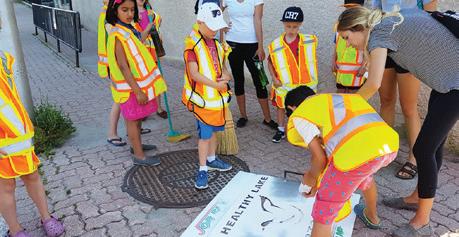
3 minute read
LOWWSF: Nine-year partnership with our neighbours has built a strong cross border connection
Nine-year partnership with our neighbours has built a strong cross border connection
Advertisement
BY TODD SELLERS, LOWWSF EXECUTIVE DIRECTOR & KELLI SAUNDERS, INTERNATIONAL WATERSHED COORDINATOR
In 2012, the Foundation had a crazy notion. What if we had a coordinator for our watershed—someone to keep all the agencies and groups on both sides of the international border collaborating and working towards common goals for the health of Lake of the Woods?
We floated the idea of a position hosted at the Foundation and shared internationally by the agencies working on Lake of the Woods. Key partners bought into this concept and the International Watershed Coordination Program (IWCP) was launched, with the support of the International Joint Commission, the (then) Manitoba Water Stewardship Department, the Minnesota Pollution Control Agency (MPCA) and the Koochiching Soil and Water Conservation District. Several years ago, Environment and Climate Change Canada joined in support of the program as well.
For nine years now, the IWCP Coordinator, Kelli Saunders, has served as the “glue” connecting and supporting groups working at local, regional, and international levels, keeping all of us working together. Key functions include assisting the IJC Board with special projects, providing secretariat coordination for the International Multi-Agency Arrangement—a collaboration of research and management agencies, and supporting civic engagement in stewardship activities across our international watershed.
Little did we know that this would grow for the next nine years to reach thousands of people around the basin. Much of the creativity, funding and drive came from our neighbours in Minnesota who knew that the work they were doing on watershed protection had to include players from Canada.

The International Watershed Program connects all working at local, regional and binational levels in the Rainy-Lake of the Woods Watershed.
This partnership has allowed for the development of real, onthe-ground community engagement projects that have drawn on the science and research that we have learned at the annual Watershed Forum, the intensive monitoring done by MPCA as part of their Watershed Restoration and Protection Strategy and the good work of tribal, First Nation and NGOs like LOWDSA in the watershed.
The first year was dedicated to understanding who the players were in the basin, building relationships with them through joint project work and enhancing communication at every opportunity. Within a short period of time, joint work efforts became the norm between Ontario, Minnesota and Manitoba.
Many of the projects we started in 2012 have become annual mainstays of our IWCP workplan. Every spring, we host a Community Engagement Workshop and every fall, it’s the annual Lake Association Network Event. LOWDSA has participated in each of these most years and has presented several times on the LakeSmart program, the Area News success and its many other initiatives. We have engaged youth—the inheritors of the lake—to paint stewardship messages beside storm drains in Kenora, Fort Frances, International Falls and Ranier, Minnesota such as “No Dumping – Drains to River” or “A Healthy Lake Starts Here”. These remind us all to be aware that what goes down the storm drain, goes into the closest lake or river. The IWCP has a locally based website that showcases the good work that our partners are doing around the basin (rainylakeofthewoods.org) and we send out quarterly newsletters that highlight research and collaboration projects that build cross-border stewardship.
In 2020, we hosted a lunchtime seven-part series called “Ask An Expert”, where we linked experts on subjects like septic maintenance, green infrastructure, algae and the Treaty #3 Water Declaration to members of the public who signed up to attend. The recordings of those sessions can be viewed at rainylakeofthewoods.org/index.php/askanexpert.
We worked with MPCA to conduct almost 40 interviews across the basin to better understand how landowners are practicing stewardship and what the barriers and challenges may be.
Every year, we promote Ontario’s Lake Partner Program and Minnesota’s Citizen Lake Monitoring Program to engage more and more volunteers in these important water quality monitoring volunteer opportunities.
It’s been a busy, productive and extremely rewarding nine years growing the IWCP with our neighbours to the south. Watershed work can’t be done successfully if the watershed itself is broken up by borders. Water knows no boundary and we are proud to have worked within this vision with Minnesota and our other partners for the past nine years!

Youth volunteers in Kenora stencil storm drains to remind us to protect our lake.










